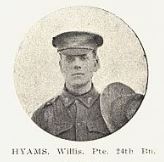Pte
William (Willie) Hyams
Information about birth
|
Year of birth: 1886 |
|
Place of birth: Melbourne, Victoria, Australia |
General information
|
Last known residence: 46 Delbridge Street, Fitzroy North, Victoria, Australia |
|
Profession: Shoemaker |
|
Religion: Judaism |
Army information
|
Country: Australia |
|
Force: Australian Imperial Force |
|
Rank: Private |
|
Service number: 5359 |
|
Enlistment date: 11/03/1916 |
|
Enlistment place: Melbourne, Victoria, Australia |
|
Units: — Australian Infantry, 24th Bn. (Victoria) (Last known unit) |
Information about death
|
Date of death: 04/10/1917 |
|
Place of death: Zonnebeke Château Grounds, Zonnebeke, Belgium |
|
Cause of death: Killed in action (K.I.A.) |
|
Age: 31 |
Cemetery
|
Buttes New British Cemetery, Polygon Wood Plot: XXIX Row: C Grave: 7 |
Distinctions and medals 2
|
British War Medal Medal |
|
Victory Medal Medal |
Points of interest 4
| #1 | Place of birth | ||
| #2 | Last known residence | ||
| #3 | Enlistment place | ||
| #4 | Place of death (approximate) |
My story
William "Willie" Hyams, was born in 1886 in Melbourne, Victoria, Australia. He was the son of Rachel and Phillip Hyams and was married to Ethel May Hyams with whom he had two daughters. On 11 March 1916, the shoemaker, enlisted in Melbourne and on 1 August 1916 he left Melbourne in aboard HMAT A28 Miltiades with the 14th reinforcement of the 24th Battalion, part of the 6th Australian Brigade of the 2nd Australian Division.
On 4 October, the Battalion was to capture Broodseinde ridge, but first they had to pass through Zonnebeke Castle Park. The 24th assembled at Tokyo. They used shell holes and old trenches to form a line.
At 5.30am, just before the battalion was to attack, German artillery began shelling the jump-off line. The Germans planned an attack of their own, hoping to recapture Zonnebeke. In the 24th Battalion alone, 40 men and two officers were killed on impact. The battalion's strength was reduced by 30 per cent even before the attack had begun.
At 6am, British and Australian artillery opened fire on the German positions and troops began to advance. The 22nd led the way, followed by the 21st and 24th. The three battalions had to storm the front over 275 metres to the right of the pond. Once beyond the pond, the units on the left had to change direction to cover their assigned ground.
As the Germans were assembling, they were caught in the field by the Allied barrage. The battered German regiments, were dispersed, killed or captured by the advancing Australians.
William, aged 30, was killed in action on 4 October 1917. Private Hyams was found after the war where he was killed, near Zonnebeke Lake, right opposite the present entrance to Passchendaele Museum (28.D.28.a.20.40). nearby the Australian starting positions. He was reburied in Buttes New British Cemetery; plot 29, row C, grave 7.
On 4 October, the Battalion was to capture Broodseinde ridge, but first they had to pass through Zonnebeke Castle Park. The 24th assembled at Tokyo. They used shell holes and old trenches to form a line.
At 5.30am, just before the battalion was to attack, German artillery began shelling the jump-off line. The Germans planned an attack of their own, hoping to recapture Zonnebeke. In the 24th Battalion alone, 40 men and two officers were killed on impact. The battalion's strength was reduced by 30 per cent even before the attack had begun.
At 6am, British and Australian artillery opened fire on the German positions and troops began to advance. The 22nd led the way, followed by the 21st and 24th. The three battalions had to storm the front over 275 metres to the right of the pond. Once beyond the pond, the units on the left had to change direction to cover their assigned ground.
As the Germans were assembling, they were caught in the field by the Allied barrage. The battered German regiments, were dispersed, killed or captured by the advancing Australians.
William, aged 30, was killed in action on 4 October 1917. Private Hyams was found after the war where he was killed, near Zonnebeke Lake, right opposite the present entrance to Passchendaele Museum (28.D.28.a.20.40). nearby the Australian starting positions. He was reburied in Buttes New British Cemetery; plot 29, row C, grave 7.
Sources 6
|
24th Battalion Australian Infantry (Australian War Memorial, Campbell (AWM), AWM4 23/41/25). https://www.awm.gov.au/ Sources used |
|
6th Brigade Australian Infantry (Australian War Memorial, Campbell (AWM), AWM4 23/6/26). https://www.awm.gov.au/ Sources used |
|
First Australian Imperial Force Personnel Dossiers, 1914-1920 (National Archives of Australia, Canberra (NAA), B2455, HYAMS W.). https://www.naa.gov.au/ Sources used |
|
Harvey W.J., The Red and White Diamond: The Official History of the 24th Battalion Australian Imperial Force (Uckfield, The Naval & Military Press Ltd, 1920), p. 179-190. Sources used |
|
McCarthy C., The Third Ypres Passchendaele. The Day-by-Day Account (London, Arms & Armour Press, 1995), pg. 99. Sources used |
|
Unit embarkation nominal rolls, 1914-18 War (Australian War Memorial, Campbell (AWM), AWM8). https://www.awm.gov.au/ Sources used |
More information 4
|
Commonwealth War Graves Commission Database https://www.cwgc.org/find-records/find-war-dead/casualty-details/480294 |
|
Lives of the First World War (Imperial War Museum) https://livesofthefirstworldwar.iwm.org.uk/lifestory/7488215 |
|
Namenlijst (In Flanders Fields Museum) https://namenlijst.org/publicsearch/#/person/_id=939436ce-7185-4707-bb9d-b97062c4f31d |
|
The AIF Project (UNSW Canberra) https://aif.adfa.edu.au/showPerson?pid=148609 |
